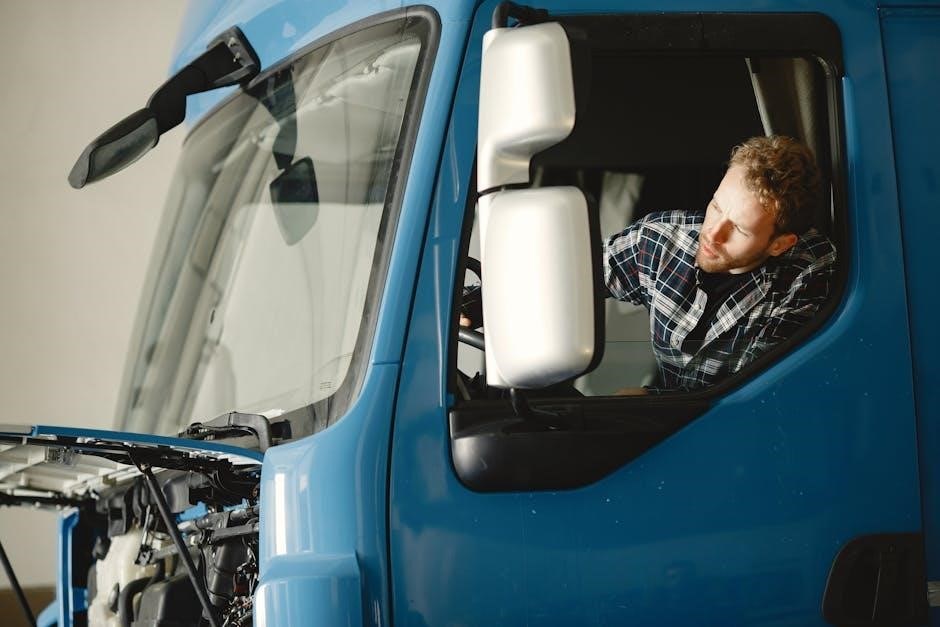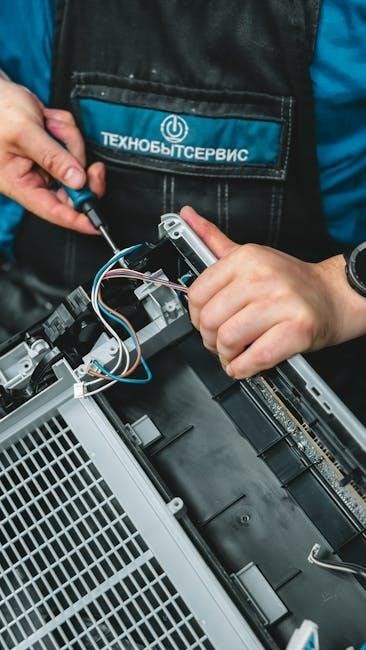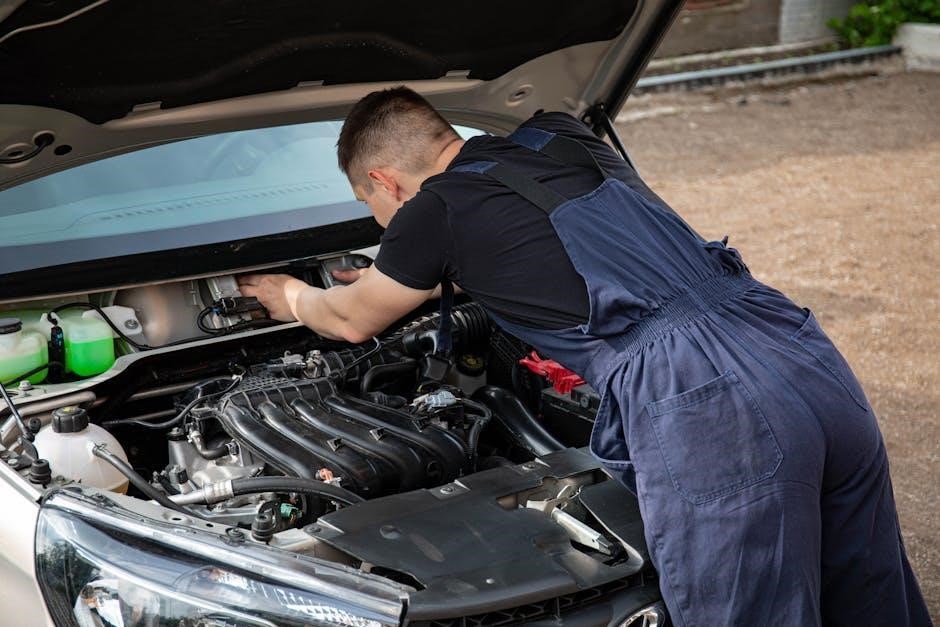
This guide provides step-by-step solutions for common Kenmore refrigerator issues, including cooling problems, unusual noises, and electrical malfunctions. Regular maintenance and consulting the user manual can prevent many issues and ensure optimal performance.
Overview of Common Issues
Common Kenmore refrigerator issues include improper cooling, freezer malfunctions, and unusual noises. Control settings may be misconfigured, causing temperature imbalances. Defrosting problems can lead to ice buildup, while faulty compressors or fan motors often cause noise. Water leaks and ice maker failures are also frequent concerns. Addressing these issues early can prevent further damage and ensure efficient appliance operation.
Importance of Regular Maintenance
Regular maintenance is crucial for extending the lifespan of your Kenmore refrigerator. Cleaning condenser coils improves efficiency, while inspecting door seals prevents air leaks. Replacing water filters and ensuring proper alignment of shelves can avoid common issues. Scheduled upkeep reduces repair needs, maintains consistent cooling, and prevents unexpected breakdowns, saving time and money in the long run.
Preparation for Troubleshooting
Gather model-specific information and consult the user manual for guidance. Familiarize yourself with safety precautions and essential tools to ensure effective and safe troubleshooting of your Kenmore refrigerator.
Safety Precautions Before Servicing
Always unplug the refrigerator from the power source before servicing to avoid electric shock. Disconnect water supply lines to prevent leaks. Turn off the ice maker and disable the water dispenser. Wear protective gloves and eyewear. Never touch internal components with wet hands or tools. Avoid contacting live wires or electrical circuits. Ensure proper ventilation in the work area. Follow the user manual’s safety guidelines to prevent accidents and ensure safe repairs.
Tools and Materials Needed
Essential tools include a screwdriver set, pliers, a multimeter, and a Torx driver for removing panels. Safety gear like gloves and eyewear is crucial. Additional materials may include a vacuum cleaner for internal cleaning, sealants for door gaskets, and replacement parts such as fuses or thermostats. Ensure all items are compatible with your Kenmore model, as specified in the manual, to avoid further damage during repairs.

Troubleshooting Cooling Issues
Common causes include control settings being too warm, control board failure, or defrosting malfunctions. Adjust settings, check components, and ensure proper operation for optimal cooling performance.
Refrigerator Not Cooling Properly
If your Kenmore refrigerator isn’t cooling, check the temperature settings. Ensure the control is set correctly and not in demo mode. Verify door seals are tight to prevent cold air from escaping. A malfunctioning control board or faulty defrost sensor could also be the cause. Unplug the unit, inspect components, and consult the manual for repair guidance. Proper maintenance can restore cooling efficiency.
Freezer Section Not Functioning
If the freezer isn’t working, check if the control settings are too warm. Ensure proper air circulation and inspect for ice buildup, which may require defrosting. Faulty sensors or a malfunctioning compressor could also cause issues. Refer to the manual for troubleshooting steps, such as resetting after a power outage or checking for electrical problems. Addressing these issues promptly can restore freezer functionality and maintain your food’s freshness.
Control Settings and Adjustments
Ensure the freezer and refrigerator controls are set correctly. Check if the temperature is too warm, as this can prevent proper cooling. Adjust the settings to the recommended levels, typically around -18°C for the freezer and 3°C for the refrigerator. If issues persist, inspect the control board or sensors for malfunctions. Adjustments may require 24 hours to take effect. Always unplug the unit before making repairs to avoid electrical hazards.

Addressing Temperature-Related Problems
Temperature issues can arise from incorrect control settings or malfunctions. Check the control board and sensors for proper function. Adjust settings to recommended levels and allow 24 hours for stabilization. Ensure defrosting cycles operate correctly to maintain efficiency and prevent ice buildup. Regularly inspect and clean components to avoid temperature fluctuations. If problems persist, consult the user manual or contact a professional for assistance. Proper maintenance ensures optimal performance and prevents food spoilage.
Freezer or Refrigerator Control Set Too Warm
If the freezer or refrigerator control is set too warm, adjust the temperature settings to the recommended levels. Allow 24 hours for the unit to stabilize. Ensure the defrosting cycle operates correctly to maintain efficiency and prevent ice buildup. Regularly inspect and clean components to avoid temperature fluctuations. If issues persist, consult the user manual or contact a professional for assistance. Proper maintenance ensures optimal performance and prevents food spoilage.
Defrosting Issues and Solutions
Defrosting issues can cause ice buildup, reducing efficiency. Check the defrost sensor and timer for proper function; Ensure the defrost drain is clear to prevent water leaks. If the compressor doesn’t restart after defrosting, inspect the wiring and controls. Refer to the manual for specific instructions. If problems persist, consult a professional to avoid further damage. Regular maintenance can prevent defrosting malfunctions and ensure smooth operation.

Identifying and Fixing Noises
Common noises like rattling or humming may stem from loose parts or malfunctioning fan motors. Check for obstructions and tighten components. Refer to the manual for specific troubleshooting steps to address unusual sounds effectively and ensure quiet operation.
Unusual Noises from the Compressor
Strange compressor noises, such as knocking or buzzing, may indicate internal wear or overheating. Check for blockages in vents and ensure proper power supply. If the compressor fails to restart within six minutes after a power outage, this could signal a malfunction. Unplug the refrigerator before inspecting internal components to avoid electrical shock. Refer to the manual for diagnostic steps and consider professional repair if issues persist.
Fan Motor Malfunction
Fan Motor Malfunction
A malfunctioning fan motor can cause reduced cooling efficiency or unusual noises. Ensure the fan is clean and free from dust buildup. If the motor is worn or faulty, it may need replacement. Verify that the fan is receiving proper power and that no electrical issues exist. Always unplug the refrigerator before attempting repairs. Consult the manual for specific diagnostic steps or contact a professional if the problem persists.

Water and Ice Maker Problems
Common issues include water leaks, ice maker failure, or reduced water flow. Check the water supply, filter, and tubing for blockages or damage. Ensure the ice maker is properly aligned and receiving power. Refer to the manual for troubleshooting steps or consult a professional if problems persist after basic checks.
Water Leaks and Ice Maker Failure
Water leaks and ice maker malfunctions are common issues. Check the water supply line for kinks or damage. Ensure the filter is clean and properly installed. If the ice maker isn’t producing ice, verify its alignment and power supply. Frozen water lines or faulty valves may cause leaks. Consult the manual for troubleshooting steps or replace damaged components. If issues persist, contact a professional for assistance.
Troubleshooting the Ice Maker
Troubleshooting the ice maker involves checking its power supply and alignment. Ensure the ice maker is turned on and properly seated. Inspect the water supply line for blockages or leaks. If ice production is slow, the filter may need replacement. Check for frozen lines or faulty sensors. Refer to the manual for specific diagnostic steps. If issues persist, consider consulting a professional or replacing the ice maker assembly to restore functionality.
Electrical and Power Issues
Ensure the refrigerator is properly plugged in and check circuit breakers or fuses. If power issues persist, inspect the outlet or consult a professional for complex repairs.
Power Supply Problems
Ensure the refrigerator is properly plugged into a functioning outlet. Check circuit breakers or fuses to confirm they haven’t tripped or blown. If issues persist, inspect the power cord for damage or wear. Avoid using extension cords, as they may cause voltage drops. Always unplug the appliance before performing repairs to prevent electric shock. For internal electrical issues, consult the user manual or contact a certified technician to diagnose and resolve the problem effectively.
Resetting the Refrigerator After Power Outage
After a power outage, unplug the refrigerator for 30 seconds to reset the system. Plug it back in and ensure the outlet is functioning. Check the circuit breaker or fuse box to confirm power is restored. Allow the appliance to stabilize for 10-15 minutes before adjusting settings. Verify the temperature controls are set correctly and monitor performance for 24 hours to ensure proper cooling. This process helps restore normal operation efficiently.

Maintenance Tips to Prevent Future Issues
Regular cleaning, filter replacement, and inspecting door seals prevent common issues; Ensure proper airflow by organizing shelves and checking drain hoses for blockages to maintain efficiency and performance.
Regular Cleaning and Filter Replacement
Regular cleaning prevents dust buildup, which can reduce efficiency. Replace water filters every six months to ensure clean water and ice. Clean condenser coils annually to maintain optimal cooling performance. Check door seals for wear and tear, and replace them if necessary to prevent air leaks. These simple maintenance tasks can significantly extend the lifespan of your Kenmore refrigerator and prevent common issues.
Checking Door Seals and Alignment
Inspect door seals regularly for cracks or wear to ensure proper closure and prevent air leaks. Misaligned doors can compromise sealing efficiency, leading to cooling issues. Adjust hinges as needed to align doors correctly. Clean seals and the frame to maintain a tight seal. Replace worn-out seals promptly to preserve energy efficiency and maintain consistent temperatures inside your Kenmore refrigerator.

When to Call a Professional
Contact a certified technician if issues persist after troubleshooting, especially for complex repairs like control board failures or compressor malfunctions. Professional expertise ensures safety and durability.
Recognizing Complex Repair Needs
Some issues require professional intervention, such as faulty control boards, compressor failures, or defrost system malfunctions. These repairs involve specialized tools and technical knowledge to ensure safety and proper appliance function. If troubleshooting steps don’t resolve the problem, it’s crucial to seek help from authorized service providers to prevent further damage and ensure warranty compliance.
Locating Authorized Service Providers
To find authorized Kenmore service providers, visit the official Sears website or contact their customer support. Enter your model number and location to access nearby authorized repair centers. Ensure technicians are certified to maintain warranty validity and guarantee reliable repairs. Additionally, check reviews and ratings to select trusted professionals for your refrigerator servicing needs.
This guide provides essential troubleshooting solutions for Kenmore refrigerators, emphasizing regular maintenance and safety. Follow these steps to ensure optimal performance and extend appliance longevity.
Final Tips for Optimal Performance
Ensure your Kenmore refrigerator runs efficiently by checking door seals, cleaning condenser coils annually, and maintaining proper airflow. Replace water filters every 6 months and avoid overloading shelves. Keep the temperature between 37°F and 40°F for the fridge and 0°F for the freezer. Regularly inspect and clean drain tubes to prevent clogs. For complex issues, consult the user manual or contact authorized service providers to maintain warranty validity and ensure safety.